Blackpool and Fleetwood Tram Road Company
History
The Blackpool to Fleetwood tramway, which commenced services on the 14th July 1898, was arguably Britain's first and only inter-urban electric tramway; it was owned and operated by the Blackpool and Fleetwood Tram Road Company, whose title appears to have been rather fluid, subtly varying between documents, tramcar liveries and uniforms.
The company had somewhat of an 'on/off' relationship with the municipal authorities at either end of the line. At the northern end, Fleetwood Urban District Council were keen to support the tramway, a fact which the company appears to have used to try to quickly push through some clauses in the legislation that would have been beneficial to them but detrimental to the council. Fortunately for the latter, this was spotted by their parliamentary agent, and whilst agreement was eventually reached, it hardly set the relationship off on the right foot.
At the southern end, Blackpool Corporation, still smarting from their experience with the Blackpool Electric Tramways Company Ltd — the operator of the corporation's electric conduit tramway between 1885 and 1892 — were intent on denying the B&FTCo access to the town. The corporation were however in need of material for their new sea wall, and the judicious offer of land to the north of the borough boundary, owned by the Gynn Estate — who stood to profit from the tramway — proved enough of a lure for the corporation to agree to build a new tramway line northwards from Talbot Rd Station to meet the tracks of the B&FTCo at the Gynn.
Whilst the line, which was built from the outset for overhead current collection, enabled the B&FTCo to work through to the centre of Blackpool (under a lease agreement), the route itself ran inland along Dickson Rd, away from the sea front. Clearly, the thought of a company operating tramcars along the sea front would have been a step too far for the corporation, an attitude that was also seen at Talbot Rd Station (and later at the Gynn), where the tracks were not connected to the existing corporation system, even though the corporation owned both of them. Although the new line was inspected at the same time as the rest of the system, it was not opened until just over two months later — on the 29th September 1898 — as some widening needed to be undertaken.
The tramway, which was standard gauge, consisted solely of a main line running roughly southwestwards from Fleetwood to Rossall, then southwards through Cleveleys, Little Bispham and Bispham, to the Gynn (in total, 8.2 miles), where it connected to the aforementioned corporation-owned tracks along Dickson Rd to Talbot St Station (circa 0.9 miles).
The B&FTCo was a highly profitable concern, routinely returning high dividends to its shareholders. The pressures of the Great War however, along with encroaching cliff erosion and the looming end of the Dickson Rd lease (1919), eventually brought the company to the negotiating table. Agreement was reached to sell the concern to the corporation — a move which rather predictably incurred the ire of Fleetwood UDC, given that 3 miles of the tramway lay within their boundary — with the corporation taking over on the 1st January 1920.
Uniforms
Despite the company operating an intensive service for the best part of twenty-two years, one heavily used by tourists, good quality photographs of staff are rare; the few that have survived however, clearly show that motormen and conductors wore single-breasted jackets bearing five silver-plated buttons (see link), two slit waist pockets and stand-up collars. The bearer's right-hand collar bore a grade badge, possibly in embroidered script-lettering; 'Conductor' was certainly used, but whether the designation for motormen was 'Driver' or 'Motorman' is currently unclear. The jackets and trousers were dark blue with red piping, and this general style does not appear to have changed at all until the take-over by Blackpool Corporation in 1920.
Caps were soft-topped with a glossy peak, and carried a large round nickel cap badge comprising the arms of both Blackpool and Fleetwood beneath a tramcar, all within a garter containing the full system title (see below). The badge was very similar in form to the early Blackpool Corporation Tramways cap badge (see link), as well as that of the City of Carlisle Electric Tramways Company (see link), with which the company shared a director. The company cap badge was sometimes supplemented with a metal, script-lettering grade badge (presumably nickel to match the buttons); 'Driver' is known, though more often than not, the standard circular badge was the sole cap adornment. The soft-topped peaked caps were superseded by tensioned-crown peaked caps around 1911/12.
Tramcar crews were required to wear licences whilst on duty, which were probably issued by Fleetwood; these were round and are thought to have been either brass or alloy rather than enamel. Many photos show tramcar crews wearing what would appear to be two licences, of different sizes (see below). This may have been because separate licences were issued by Fleetwood and Blackpool, the latter presumably issuing enamel licences similar to those issued to crews working for Blackpool Corporation Tramways (see link) and the Blackpool, St Anne's and Lytham Tramways Company (see link).
Inspectors wore fairly typical tramway inspector garb, namely: single-breasted jackets with hidden buttons (or more likely hook and eye fasteners), edged in a finer material than the main body, and with stand-up collars; the latter almost certainly bore the grade — 'Inspector' — in embroidered script lettering. Caps were of the drooping-peak type, and bore the grade, probably in embroidered script lettering. The B&FTCo also employed the services of a more senior grade, probably a Chief Inspector. In the early years at least, this gentleman was issued with a long, single-breasted coat, edged in a finer material than the main body, which was also used to embellish the sleeves (probably with chevrons) and the front of the jacket (with bandsmen's frogs). The coat had stand-up collars, which almost certainly bore the grade in embroidered script lettering, along with braided epaulettes, though the latter cannot be made out with certainty on the surviving photograph. The drooping-peak cap was probably identical to those worn by inspectors, though presumably bearing the more senior grade.
In keeping with the inter-urban nature of the line, the B&FTCo also employed the services of Station Masters. These men appear to have been issued with the same uniforms as tramcar crews, though evidence for this is at best circumstantial.
In common with the vast majority of UK tramway systems, the B&FTCo employed the services of women during the Great War to replace men lost to the armed services. These ladies were issued with single-breasted jackets with five buttons, four pockets (with button closures), epaulettes and high, fold-over collars; the latter were devoid of insignia. Headgear took the form of a felt bonnet; this bore a standard, off-the-shelf, script-lettering grade badge — 'Conductor' — seemingly worn without the usual circular company badge. The ladies were also provided with untailored, double-breasted greatcoats, presumably the same pattern as those worn by their male colleagues.
Further reading
For a comprehensive history of the Blackpool and Fleetwood Tramroad, see: 'Stopping Car to Fleetwood — the Story of the Blackpool and Fleetwood Tramroad' by Brian Turner; Heathfield Publishing (2018).
Images
Motormen and conductors
The motorman of B&FTCo Boxcar No 14 — brand new and standing in North Albert Street, Fleetwood in 1898 — cuts a rather proprietorial figure whilst scrutinising the cameraman. He is wearing a single-breasted jacket with two slit waist pockets and stand-up collars. His cap is soft-topped with a glossy peak, and carries a large, circular B&FTCo cap badge, along with a script-lettering grade badge, 'Driver'. It is unclear why he is not wearing a licence, as other staff in the larger shot (not shown here) are certainly wearing them. Photo courtesy of the Brian Turner Collection.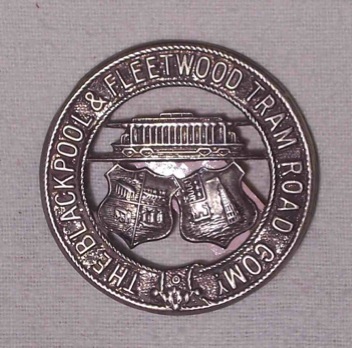
Blackpool and Fleetwood Tram Road cap badge — nickel. The title has 'TRAM' and 'ROAD' as two separate words, whereas the tramcars had them as a single word. The company seems to have been particularly blasé in this regard, never really being sure itself which was the correct form. Author's Collection.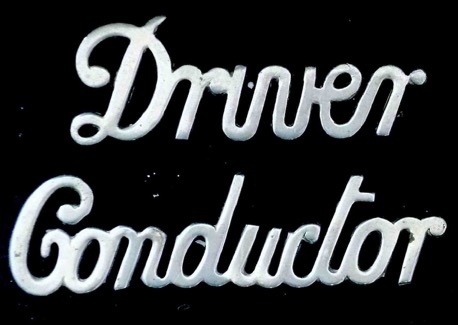
Standard, 'off-the-shelf', script-lettering grade badges of the type used on B&FTCo tramcar crew caps— nickel. Author's Collection.
Boxcar No 23 stands at the Talbot Road terminus in Blackpool along with its crew and an inspector — although the photo is undated, it is thought to have been taken around 1900. The motorman (left) and conductor (right) are both wearing the standard cap badge, but seemingly without a grade badge. Photo courtesy of the Brian Turner Collection.
An enlargement of the above photograph showing the conductor, whose right-hand collar bears his grade — 'Conductor' — possibly in embroidered script-lettering. He would appear to be wearing two round licences, but of different sizes. Photo courtesy of the Brian Turner Collection.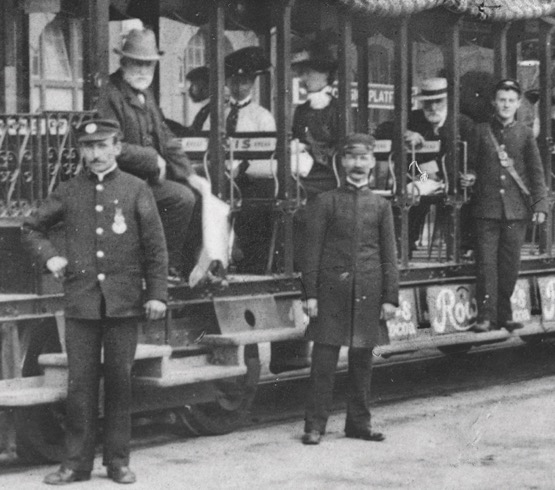
Another shot taken at Talbot Rd around 1900 with a motorman (left), the chief inspector (centre) and a conductor (right). Once again, both crewmen are wearing two licences each (of different sizes). The motorman is wearing the standard cap badge, without a grade badge. Photo courtesy of the Brian Turner Collection. 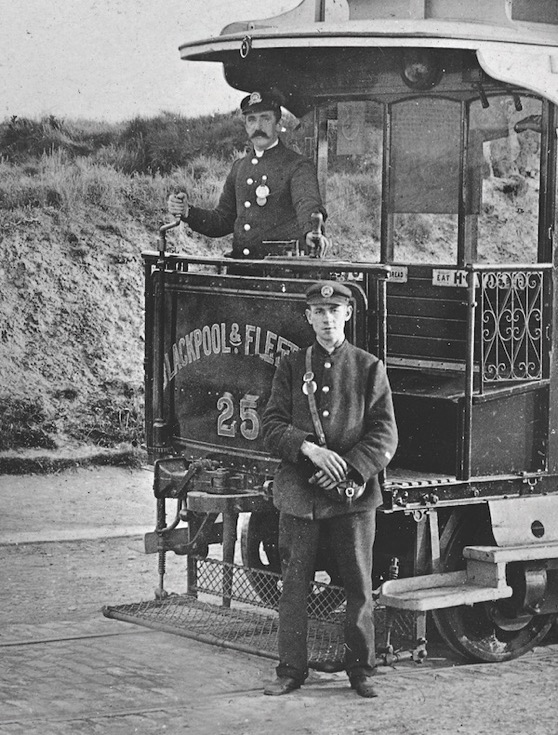
The crew of B&FTCo 'Rack' No 25 captured for posterity in Red Bank Road circa 1910. Both men are wearing single-breasted jackets, along with soft-topped caps bearing the standard B&FTCo cap badge. Photo courtesy of the Brian Turner Collection.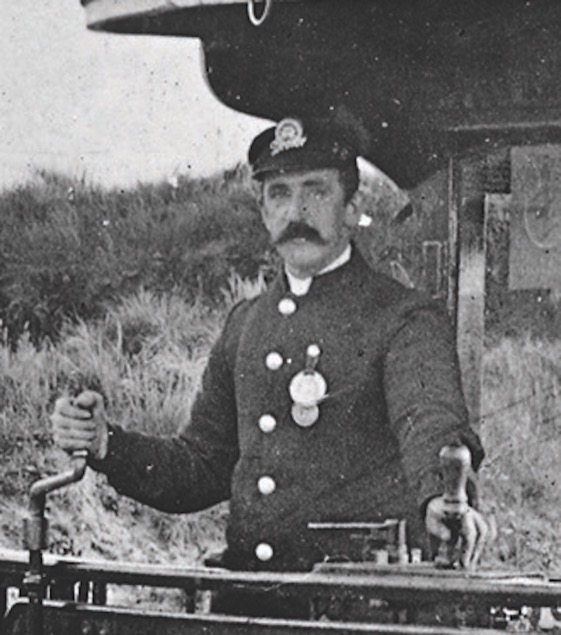
An enlargement of the above photograph showing the motorman who, as well as the standard cap badge, is wearing a script-lettering grade badge, 'Driver'. He is once again wearing two licences of different sizes. Photo courtesy of the Brian Turner Collection.
B&FTCo Boxcar No 14 stands at Cleveleys around 1913 with the crew (left), and an individual (right) who may be the Station Master. Photo courtesy of the Brian Turner Collection.
A blow-up of the above photograph showing the crew. The conductor is probably a summer extra as he is wearing informal attire, namely: a self-purchased overcoat and a flat cap. The motorman on the other hand is wearing the standard uniform, but now with a tensioned-crown peaked cap. Although he doesn't appear to be wearing the standard B&FTCo cap badge, this is probably obscured by the wide crown of the cap. Photo courtesy of the Brian Turner Collection.
Senior staff
An enlargement of the 1900 Talbot Road photograph above showing the inspector. He is wearing fairly typical tramway inspector garb, comprising a single-breasted jacket with stand-up collars bearing his grade — 'Inspector' — probably in embroidered script-lettering. His cap is probably of the drooping-peak type; it bears his grade — 'Inspector' — again probably embroidered. Photo courtesy of the Brian Turner Collection.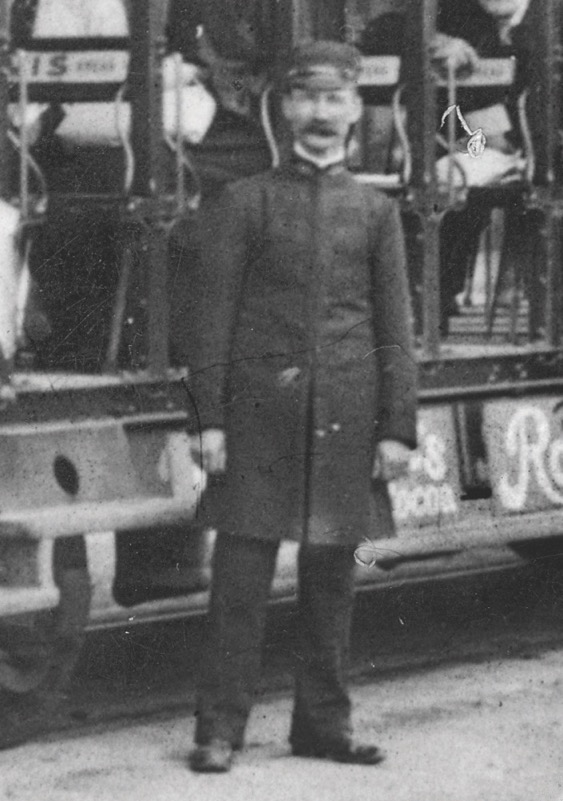
An enlargement of one of the Talbot Road photographs above showing an individual who probably holds the grade of Chief inspector or Traffic Superintendent. He is wearing a long, single-breasted coat embellished with bandsmen's frogs and braiding. The stand-up collars bear a badge of some description, presumably his grade, though this cannot unfortunately be made out on this photograph. Although no badge is in evidence on his drooping-peak cap, it almost certainly bore his grade. Photo courtesy of the Brian Turner Collection.
An enlargement of the 1913 photograph above taken at Cleveleys, and showing an individual who may possibly hold the grade of Station Master. He is wearing a double-breasted greatcoat with plain buttons and high, fold-over collars, devoid of insignia except for his licences. His cap bears the standard cap badge and may also have a hat band of a lighter colour. Once again he appears to be wearing two different licences, which may suggest that he is actually a motorman, as station masters would not ordinarily have been licenced. Photo courtesy of the Brian Turner Collection.
Female staff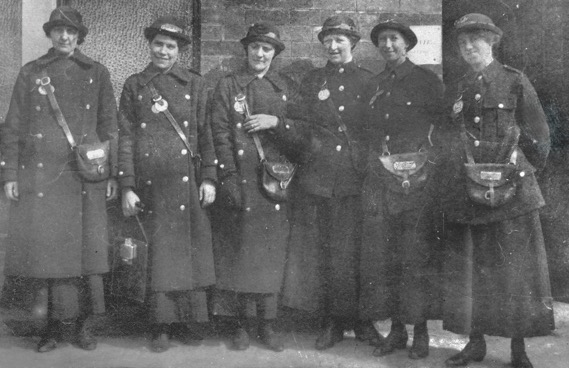
A very rare shot of B&FTCo Great War conductresses, taken at Bispham depot. At least three of the ladies, if not all of them, are wearing script-lettering grade badges — 'Conductor' — but there is no sign of the standard B&FTCo circular cap badge. Photo courtesy of the Brian Turner Collection.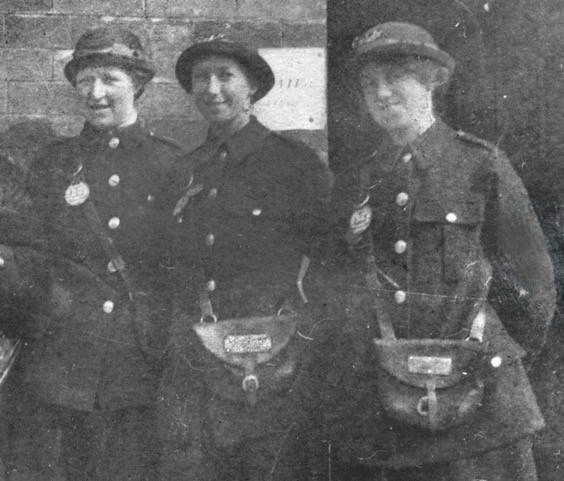
An enlargement of the above photograph showing the three conductresses on the right. All three are wearing licences on their cash-bag straps. Photo courtesy of the Brian Turner Collection.